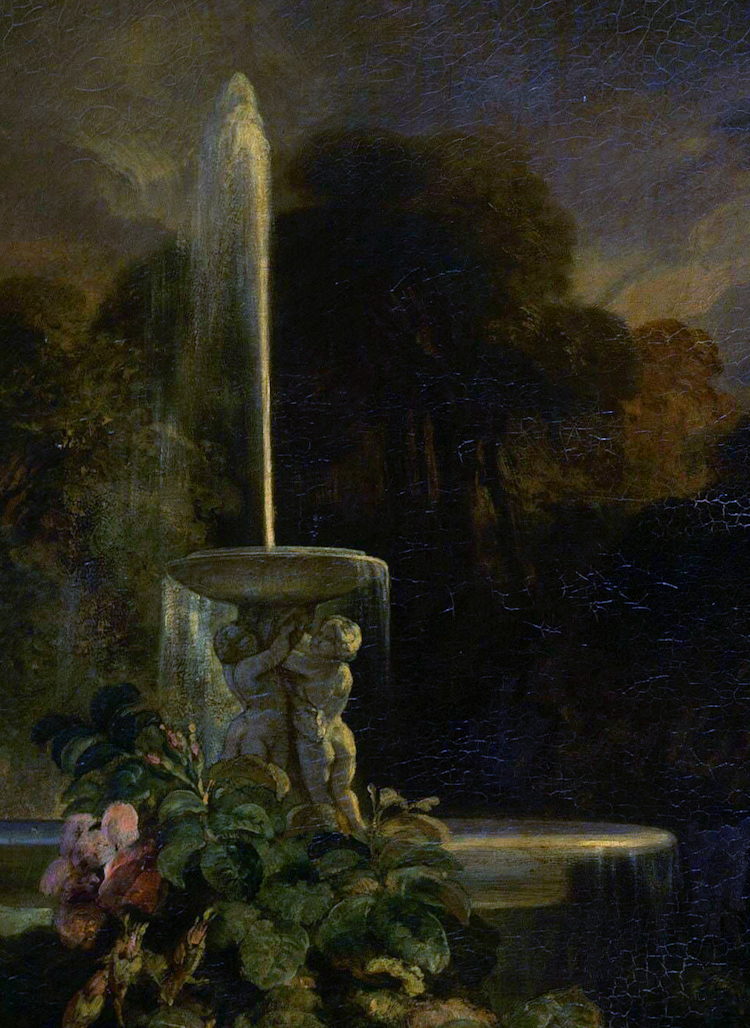Victoire, duchesse de Nemours (14 February 1822, Vienna - 10 December 1857, Claremont House), born Princess Victoria Franziska Antonia Juliane Luise of Saxe-Coburg and Gotha, daughter of Prince Ferdinand of Saxe-Coburg and Gotha and Maria Antonia Koháry de Csábrág. She was first cousins with both Queen Victoria - with whom she was very close - and Prince Albert, as well as with the future Belgian king, Leopold II, and his sister, Empress Carlota of Mexico.
 |
With its heavy craquelure and extremely discolored varnish, this painting has fared far worse than most Winterhalters; in general, his work has
aged very well. I suspect there has been some overpainting - especially on the face - in an effort to temporarily "clean up" this portrait. One can
only hope that a full conservation/restoration has been carried out on the painting since this image was taken. |
In 1840, she married Louis, duc de Nemours (25 October 1814, Paris - 26 June 1896, Versailles), born Prince Louis Charles Philippe Raphaël d'Orléans, second son of Louis-Philippe King of the French. They had three children before the coming of the revolution of 1848 and the fall of the monarchy
, at which point they fled to England and settled with his parents at Claremont House in Surrey. Nine years later, the couple had a fourth child, but the duchesse died two months after her daughter's birth. She was thirty-five. Her husband would die at the age of eighty-one, having outlived his wife by thirty-nine years.
 |
| Even obscured by the badly discolored varnish, Winterhalter's rendering of the lace is exquisite. |
***
 |
| The marriage of the duc and duchesse de Nemours, the Château de Saint-Cloud, 27 April 1840. Painting by Henri Félix Emmanuel Philippoteaux. |
 |
| Copy of another portrait of the duchesse by Winterhalter, circa 1840; the original is in an oval format. |
 |
| The duchesse in England in 1852, with her two sons, Gaston, comte d'Eu, and Ferdinand, duc d'Alençon. |
 |
| Winterhalter's double portrait, called "The Cousins": the duchesse de Nemours and Queen Victoria, 1852. |
 |
| The duchesse de Nemours on her deathbed, 1857. |

















I've never understood the death photographs the Victorians loved so much. creepy!! That first portrait is just exquisite despite the varnish. Luminous even and I love the detailing in the jewelry. Happy New Year!
ReplyDeleteI know what you mean about the death photographs, Stefan. Even though I've included a couple in posts along the way, I always feel rather squeamish about it; they're really just too intimate.
DeleteThe ugliest hairstyle ever.
ReplyDeleteI don't know, it has a lot of competition down through the centuries. Even only going back a decade, to the 1830s... yikes!
DeleteThe marble, life-size funerary portrait of the Duchesse carved by Chapu is superb. She is shown reclining on a sort of divan, head slightly to her right, her famous locks given prominent attention. (Apparently, she was combing her hair when she suddenly died, aged just 35.) Her remarkable image was to be seen in a side chapel of St Charles Borromeo, Weybridge. Relatively soon after her death at Claremont in the 1850s, she had been moved upstairs from the Catholic Taylor family crypt: in that way, Queen Victoria, travelling across from nearby Windsor, was able to visit her cousin via a discrete private side door, thereby not entering the church proper. The Duchess of Nemours’ remains were taken to the Orleans mausoleum in Dreux in 1979, rejoining those of King Louis Philippe and his wife, Amalie (a niece of Marie Antoinette) and various other royal Orleans exiles who, over the years, had been interred at Weybridge. All their coffins (bar that of the Duchesse, the exception being most likely at the Queen’s request), had been repatriated in late-Victorian times. Today, Chapu’s extraordinary marble effigy resides in a Manchester art gallery.
ReplyDeleteI just Googled the effigy; it's quite lovely. Thank you for calling my attention to it.
Delete